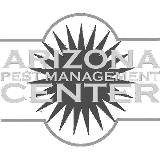This is the time of year in Yuma County when both downy and powdery mildew can be present in lettuce fields. There are some straightforward clues that will help identify which mildew disease is present. Symptoms. Spots or lesions caused by downy mildew can first appear as one or more yellowish areas on the upper leaf surface usually bordered by leaf veins, giving the affected portions of the leaf a somewhat angular appearance. In time, these lesions will increase in number and older ones will turn brown and necrotic. On the other hand, first evidence of powdery mildew is the appearance of very small circular colonies of the pathogen growing on the upper or lower lettuce leaf surfaces. Over time, these colonies enlarge, produce spores that start new colonies, and eventually the entire leaf surface can become covered with the powdery mildew pathogen. Spores. Spores of the downy mildew pathogen (Bremia lactucae) usually arise from the underside of leaves, are egg-shaped, and are produced singly on the ends of branching mycelium, much like fruit are borne on many types of fruit trees. Large numbers of this spore-bearing mycelium and attached spores produce the downy white growth that we see, again usually on the bottom surface of leaves. Keep in mind that on head lettuce, the undersidc of the leaf can appear to be the upper surface due to the curving of leaves to form the lettuce head. However, for the powdery mildew pathogen (Golovinomyces cichoracearum), spores are produced in chains on pathogen mycelium growing on either side of lettuce leaves, giving the appearance of powder on the leaf. Required environment. Development of downy mildew requires free moisture on leaves, which can be supplied by rainfall, dew, or sprinkler irrigation. In contrast, powdery mildew development requires moderate to high relative humidity, but not free moisture. In fact, free water will kill spores of the powdery mildew pathogen. Due to changing environmental conditions during growth and maturation of a lettuce crop, it is possible to have both mildew diseases on lettuce at the same time.






